In the old days there existed 200 or more traditional Diné healers.* “Now,” Thomas Hatathli told us, “There are only 30 to 40.” As I listened to Thomas’ words my heart felt a tug of sadness to be hearing again what I’ve heard so often—directly from the Indigenous healers themselves. And I imagined what it’s like to be one of a dwindling few, and perhaps the only one left in some cases, who dedicate their lives to the wholeness of their people and the planet, living the ancient principles every day.
We’re honored that Thomas accepted our invitation to share some of the work he does as a traditional healer of his people.** Tall and spare, Thomas radiates a quiet strength. He began with a prayer. Then he introduced himself by citing his clan relations, adding, “This is who I am. I know I’m never alone.” And I got the true understanding that knowing your origins, stretching back centuries, gives of itself to spiritual grounding.
 Perhaps Thomas was preordained to be a medicine man by virtue of the Diné meaning of his last name and precedent set by his grandfather. But Thomas didn’t always follow that path. It wasn’t until, after being away at college, when he came home to find his family’s livestock gone—taken from them by the Federal Government—the family forced by the same to uproot from their ancestral lands and move across Arizona, to enter into homelessness while they awaited the allotted acre and house…that he made a decision. His family was devastated. His people suffered. Mental and physical health were dramatically impacted. Spiritual grounding detached itself to be replaced by the worst influences. ***
Perhaps Thomas was preordained to be a medicine man by virtue of the Diné meaning of his last name and precedent set by his grandfather. But Thomas didn’t always follow that path. It wasn’t until, after being away at college, when he came home to find his family’s livestock gone—taken from them by the Federal Government—the family forced by the same to uproot from their ancestral lands and move across Arizona, to enter into homelessness while they awaited the allotted acre and house…that he made a decision. His family was devastated. His people suffered. Mental and physical health were dramatically impacted. Spiritual grounding detached itself to be replaced by the worst influences. ***
For the next four years, Thomas dogged the heels of his cousin, already a medicine man, learning the songs, prayers and rituals, the teachings of his ancestors. Until finally, he was ordained as a healer and Blessingway Chanter. That was more than 25 years ago.
He retains little time as his own. Weekdays he works as a mental health specialist at the Tuba City Regional Health Care Center. And nearly every day people come looking for him, asking him to sing the songs and release the prayers that bring healing. Thomas freely gives of himself to do so. Nights and weekends are not his but theirs. To maintain balance, he runs. Thomas has run 16 Boston Marathons—soon his 58th marathon total. He shows no signs of slowing down.
That evening he dispensed pragmatic wisdom in an unassuming way, just stated fact. And even though I’d heard what he said before, presented in any number of ways, his way slipped in to find a home. Much of what he offered was about gratitude and presence, making good choices—the underpinnings of a healthy life in all ways.
He spoke of chewing his food in gratitude and what’s best for the body…
When I chew my food I taste it. I enjoy it. I break the food down to give my stomach a break. In this way I conserve my energy for when it’s needed.
The body needs movement to be healthy. People say they don’t have time.
When he spoke of people leaving their traditions in favor of technology and assimilating into Western culture…
Go forward but reach back.
Of the ancient prayers and songs orally handed down to him…
When I pray it’s a thousand years of wisdom coming through my mouth.
As the end of the evening came to a close, he spoke of the Blessingway Ceremony he would lead the next morning. I stood and asked, “As this will be a healing ceremony, is there a way we can best prepare ourselves for tomorrow?”
He answered…
Just be you.
His practical spirituality is comforting. And it’s evident his life is one of alignment to core values, to family and community. Yet it’s also true his life is one of great sacrifice—one he chooses.
Nothing good comes easy. We need to appreciate effort.
True medicine men don’t choose that path. It chooses them. It means relinquishing an everyday life and surrendering to sacrifice, one that ultimately works at a global level.
***
This is Part One of a two-part article. Part Two is on the Blessingway Ceremony in which I was the patient seeking to return to the natural order offered through these songs, prayers and rituals. Read Part Two.
I wish to express gratitude to the Native people who attended this offering and showed respect to this Elder: Naomi Tsosie, Lucilia Benally, De Alva Ward, Ron Interpreter and Sam Hogue. I also acknowledge Ruth Harrison, Kimberly Ewing, Nathan Shannon and Norm Meier who were present and contributed their memories of our time with Thomas, filling in where my own memory gapped.
***
*The name Diné means “The People” in their own language. By the 1600s the Spanish began calling them Navajo derived from the Tewa-Pueblo word for “great planted fields.”
**Twice a year Kenosis Spirit Keepers sponsors an educational outreach program for the general public in which participants can learn and experience the teachings of Indigenous peoples from spiritual leaders and healers who serve their community. We call it the Spirit Keepers Series.
***To gain an understanding of the devastation wrought from The Long Walk in the 1860s, the 1974 Navajo-Hopi Land Settlement Act, the forced boarding schools and acts in-between, the residual trauma which extends all the way to present time for Diné and Hopi alike, read A Historical Overview of the Navajo Relocation published by Cultural Survival.

